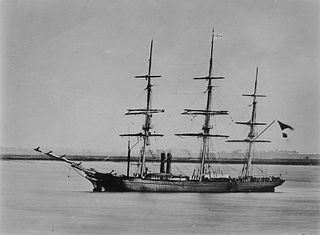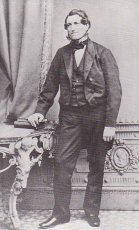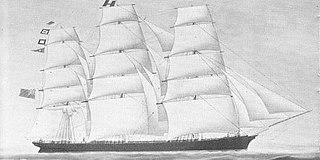
A clipper was a type of mid-19th-century merchant sailing vessel, designed for speed. Clippers were generally narrow for their length, small by later 19th century standards, could carry limited bulk freight, and had a large total sail area. "Clipper" does not refer to a specific sailplan; clippers may be schooners, brigs, brigantines, etc., as well as full-rigged ships. Clippers were mostly constructed in British and American shipyards, though France, Brazil, the Netherlands and other nations also produced some. Clippers sailed all over the world, primarily on the trade routes between the United Kingdom and China, in transatlantic trade, and on the New York-to-San Francisco route around Cape Horn during the California Gold Rush. Dutch clippers were built beginning in the 1850s for the tea trade and passenger service to Java.

Ariel was a clipper ship famous for making fast voyages between China and England in the late 1860s. She is most famous for almost winning The Great Tea Race of 1866, an unofficial race between Foochow, China and London with the first tea crop of the 1866 season.

Blackadder was a clipper ship, a sister ship to Hallowe'en, built in 1870 by Maudslay, Sons & Field at Greenwich for Jock Willis & Sons.

Taitsing was a famous British tea clipper.

Sir Lancelot was a clipper ship which sailed in the China trade and the India-Mauritius trade.

Challenger was a wooden clipper ship built in 1852 by Richard & Henry Green, in their Blackwall Yard for Hugh Hamilton Lindsay, London. She was the 291st ship built by the yard and was a remarkable departure from the previous ships produced. In 1850 the American clipper ship Oriental visited West India Docks, the largest clipper ship to visit London and the Admiralty was given permission to take her lines, and this was done by Messrs Waymouth and Cornish, both Lloyd's Surveyors, in the dry dock at Green's Yard in Blackwell. This is probably the reason that it was said that Challenger's design was inspired by and had a close resemblance to the Oriental's.

The Taeping was a clipper ship built in 1863 by Robert Steele & Company of Greenock and owned by Captain Alexander Rodger of Cellardyke, Fife. Taeping participated in The Great Tea Race of 1866 and narrowly defeated the Ariel. The ship's captain was Donald MacKinnon of Heanish, Tiree. It was wrecked on 22 September 1871 by Ladd's Reef in the South China Sea while traveling to New York.

In the middle third of the 19th Century, the clippers which carried cargoes of tea from China to Britain would compete in informal races to be first ship to dock in London with the new crop of each season. The Great Tea Race of 1866 was keenly followed in the press, with an extremely close finish. Taeping docked 28 minutes before Ariel - after a passage of more than 14,000 miles. Ariel had been ahead when the ships were taken in tow by steam tugs off Deal, but after waiting for the tide at Gravesend the deciding factor was the height of tide at which one could enter the different docks used by each ship. The third finisher, Serica, docked an hour and 15 minutes after Ariel. These three ships had left China on the same tide and arrived at London 99 days later to dock on the same tide. The next to arrive, 28 hours later, was Fiery Cross, followed, the next day, by Taitsing.

Fiery Cross was a famous British tea clipper which sailed in the Great Tea Race of 1866. She was the first ship home in the tea seasons of 1861, 1862, 1863, and 1865.
Flying Spur was a British tea clipper, built of teak and greenheart in 1860.

Ambassador is a United Kingdom tea clipper built in 1869. She was a composite clipper, built with wooden planking over an iron skeleton and was W. Lund & Co's first tea clipper. She is now a beached wreck in southern Chile.

Sylph was a clipper ship built at Sulkea, opposite Calcutta, in 1831 for the Parsi merchant Rustomjee Cowasjee. After her purchase by the Hong Kong-based merchant house Jardine Matheson, in 1833 Sylph set a speed record by sailing from Calcutta to Macao in 17 days, 17 hours. Her primary role was to transport opium between various ports in the Far East. She disappeared en route to Singapore in 1849.

Lahloo was a British tea clipper known for winning the Tea Race of 1870, and finishing second in the Tea Race of 1871. She sailed from Foochow to London with over a million pounds of tea in 1868.

Lord of the Isles was the first iron-hulled tea clipper, built in Greenock in 1853. She served in the tea trade until 1862, and also made voyages to Australia. She is known for a record passage between Greenock and Shanghai, and for her close finish in the 1856 Tea Race from China to England, docking in London just ten minutes before Maury. This race was the basis for the plot of a 1927 movie by Cecil B. DeMille The Yankee Clipper.

Stornoway was a British tea clipper built in Aberdeen, Scotland in 1850. It has been suggested that she was the first clipper built in Great Britain.

Kaisow, a composite clipper, was built by Robert Steele & Company at Greenock and launched on 19 November 1868.

James Killick was a British sea captain, shipowner and entrepreneur. He founded Killick Martin & Company with James Henry Martin.

Wylo a composite clipper was built by Robert Steele & Company, Greenock, and launched on 15 April 1869. Robert Steele & Company also built the famous clippers Ariel and Taeping who took part in the great tea race of 1866, and Sir Lancelot another renown clipper ship.

Osaka, A composite barque, built by William Pile, Sunderland, at Yard No. 179 for Killick Martin & Company, the company founded by Captain James Killick and launched on 12 July 1869. William Pile also built Osaka's sister ship Miako, for Killick Martin & Company launched on 15 April 1869.
James Henry Martin was a British shipowner and entrepreneur. He founded Killick Martin & Company with James Killick.















